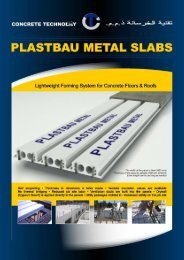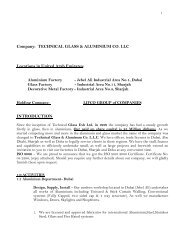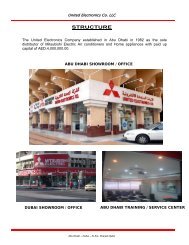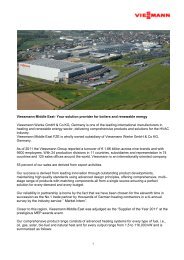Pearl Building Rating System - Estidama
Pearl Building Rating System - Estidama
Pearl Building Rating System - Estidama
You also want an ePaper? Increase the reach of your titles
YUMPU automatically turns print PDFs into web optimized ePapers that Google loves.
RE-R1: Minimum Energy Performance<br />
Intent To create a decision-support tool to assist the project team in making informed<br />
decisions about the options, implications and benefits of various aspects of the building<br />
design in order to achieve a minimum level of energy efficiency.<br />
Credit<br />
Requirements<br />
Requirement<br />
Achievement<br />
Credit<br />
Submission:<br />
Design <strong>Rating</strong><br />
Credit<br />
Submission:<br />
Construction<br />
<strong>Rating</strong><br />
Calculations and<br />
Methodology<br />
GENERAL<br />
Develop an energy model for the proposed building(s) using appropriate dynamic<br />
simulation modeling software and calculate the baseline building energy consumption<br />
according to the building performance rating method outlined in Appendix G of<br />
ANSI/ASHRAE/IESNA Standard 90.1-2007, using the minimum acceptable standards for<br />
building fabric, HVAC, service water heating, power, lighting and other equipment.<br />
Demonstrate a minimum 12% performance improvement compared to the baseline<br />
building performance demonstrated by the energy simulation model as per the<br />
methodology outlined within Appendix G of Standard 90.1-2007.<br />
ADDITIONAL REQUIREMENT/CLARIFICATIONS<br />
None<br />
This is a requirement. There are no Credit Points awarded.<br />
�<br />
� Energy Model Template summarizing the dynamic energy simulation, confirming<br />
that the minimum requirements of this credit will be achieved.<br />
� Updated Energy Model Template summarizing the dynamic energy simulation,<br />
confirming that the minimum requirements of this credit have been achieved.<br />
The method for determining reductions in energy consumption is outlined within the<br />
Performance <strong>Rating</strong> Method of ANSI/ASHRAE/IESNA Standard 90.1-2007 (Appendix G).<br />
Appendix G provides a methodology for rating the energy efficiency of building designs.<br />
Compliance with the performance rating method requires that the mandatory provisions<br />
outlined in sections 5.4, 6.4, 7.4, 8.4, 9.4 and 10.4 of Standard 90.1 – 2007 all be met.<br />
Minimum acceptable standards for building fabric, HVAC, service water heating, power,<br />
lighting and other equipment for use within the baseline model must be set at either<br />
those given in Standard 90.1 – 2007 or local code, whichever is more stringent.<br />
The building air leakage rate must be set at the more stringent of 3.64 l/s/m 2 at 75 Pa<br />
or local code, and be modelled identically in both the baseline and proposed building.<br />
If the project can demonstrate a requirement for improved air tightness performance is<br />
in place, this figure may be used in the proposed building design only if a full envelope<br />
air tightness test is to be carried out and the general contractor is under contract to<br />
achieve the required air leakage rate. The air tightness test must be carried out by a<br />
qualified and competent body (such as ATTMA member organisations or similar UKAS<br />
accredited organisations) and all test results and compliance certificates awarded to<br />
the project.<br />
Unlike in Appendix G, performance improvements within the <strong>Pearl</strong> <strong>Rating</strong> <strong>System</strong> are<br />
based on reductions in annual energy consumption (kWh) rather than cost, thus all<br />
reference to energy rates within Appendix G must be ignored.<br />
<strong>Pearl</strong> <strong>Building</strong> <strong>Rating</strong> <strong>System</strong>: Design & Construction, Version 1.0, April 2010 141 of 223







